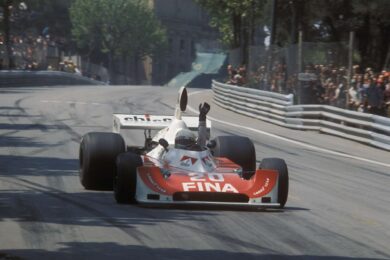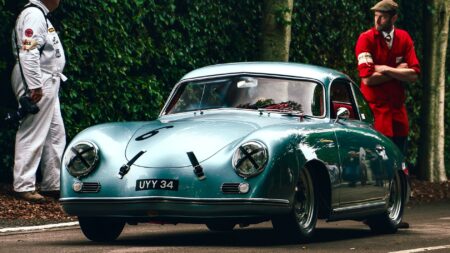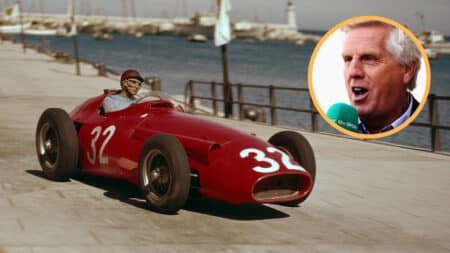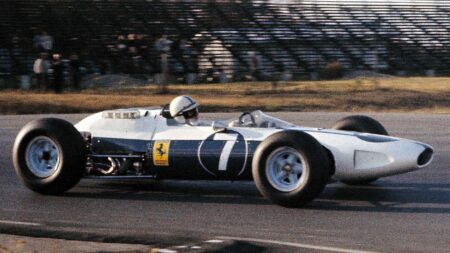
Paradise lost: Montjuïc and the 1975 Spanish Grand Prix
Try to imagine your ideal street track, and the only limits are your imagination. It would be fast and challenging; a touch daunting. It would have sharp gradient changes –…
The 1955 Mille Miglia is approaching fast and Mercedes-Benz team manager Alfred Neubauer is dictating the final details of the race to his secretary Gertrude.
He starts by outlining the date and timings of the race and advises that the cars won’t be driven to their technical inspection on Friday April 29 to avoid clutch wear. The checkpoints at Ravenna, Pescara, Rome, Florence and Bologna are outlined and he goes on to explain what needs to be at each stop.

“For windscreen replacement in an emergency,” he dictates, “three windscreens of Perspex and three of sheet metal must be taken along. In addition there will be cleaning materials for use by the drivers: four water buckets, four sponges, four chamois leathers, four bars of soap, four towels, two watering cans. Also to be kept available, toilet roll.
With Moss in the Mille Miglia
Celebrating the 50th anniversary
The design of the 300SLR
“Chocolate will be provided for something to eat and the drivers will inform us of any other wishes. The drinks available will be still water, vermouth, brandy and hot water.”
Mercedes’ preparations for the debut of its 300 SLR in the ’55 Mille Miglia had been fastidious and despite not having any Italians in the driver line up, who would know the roads well, they arrived in Brescia at the end of April favourites to win. Unsurprising perhaps when you consider that alongside the 25-year-old Stirling Moss they could also call on the talents of Juan Manuel Fangio, Karl Kling and Hans Herrmann.
Today, May 1, is the 60th anniversary of Stirling Moss and Denis Jenkinson’s epic (I don’t use that word lightly) win in the Mille Miglia. The facts are staggering: 1000 miles on public roads in 10 hours, seven minutes and 48 seconds at an average speed of 97.9mph and with top speeds of 180mph. It was enough to break the previous year’s winning time by an hour and 20 minutes.

Moss and Jenks had spent hours making notes on the route and rolled these up into a box so that Jenks could act as navigator and let Moss know whether a blind brow was flat or not. “We tried every intercom we could find,” Moss tells me as we sit in a hotel reception near Florence, metres away from the ’55 Mille Miglia route. Outside are three 300 SLRs – 722, 704 and 658 – and soon I’ll be a passenger in Herrmann’s SLR, number 704.
“Nothing we tried worked,” Moss continues, “even the most sophisticated ones, and when I was going flat out I couldn’t hear Jenks at all. When you’re concentrating 100 per cent I think your hearing goes in the same way that if you have your leg up against a really hot panel you wouldn’t feel it. It’s the way we’re made up I think.”
Herrmann had also opted for a navigator – engineer Hermann Eger – and was convinced it was the better option for non-Italians. “Fangio and Kling decided to drive by themselves,” remembers Herrmann, “and on some sections it was faster, like here, between Florence and Bologna – there are lots of corners and it wasn’t difficult to see where you were going. On the sections with long straights, though, like from Pescara to Rimini, we were at an advantage because of the passenger.”
Come the end of the race Herrmann was stuck at the top of the Futa Pass because of a glitch with his fuel filler cap, but Fangio, on his own for all 1000 miles, managed to finish second, just over 30 minutes behind Moss and Jenks.

“The Mille Miglia was the only race that frightened the shit out of me,” Moss says. “But once you got going you didn’t think about it. It was so much fun driving on public roads and going flat out was quite exciting. Also, the 300 SLR really came into its own after 120mph.” After 120mph? The speeds, even today, are astonishing and Moss knew that in order to be competitive he “had to be at 180mph for reasonable lengths of time”. And this was on public roads which weren’t even closed for the event! Thankfully the locals knew to stay well clear of them, but animals tended not to.
As my chat with Moss draws to an end the SLRs are started up outside, the bark of the eight-cylinder engines echoing through the hotel lobby. “That’s it!” says Moss. “What a fantastic sound.” Moss will be in 722 accompanied by a Mercedes-Benz Classic mechanic and as a trio we’ll head over the Futa and Raticosa Passes. I squeeze into 704 having removed the back of the passenger seat and the first thought is how uncomfortable it is – Jenks was a foot and a half shorter than me… The driver is DTM racer Christian Vietoris and he’s already done a few miles in the car (the first miles he’s ever done behind the steering wheel of a classic).
“It’s much better than I expected,” he says, referring to the SLR. “I’m really impressed by it – the gears feel really clean and crisp, the brakes are OK and the balance is amazingly good. You get lots of feedback as well which you just don’t get with modern cars. I can’t even remember when I last used a gearstick…” I ask whether he could imagine racing the SLR over 1000 miles of public roads and he just laughs and says “nope”.

Ginetta: Episode 2
Ginetta: Episode 1
“Bernie came from heaven…”
We pull out of the car park and peel onto the road leading to the Futa Pass. Vietoris snatches second and lets the revs rise – the twin exhausts exit the SLR’s bodywork inches from my right leg and while the vibrations seep through the seat, the heat pours into the footwell and the scream of the exhaust fills my ears. How on earth, though, did Moss and Jenks cope with 10 hours of this? It’s an amazing feeling being in the car on these roads, one I’ll never forget, but it’s raised more questions than I had before.
The 1955 Mille Miglia win has always been an incredible feat of human endeavour. Having now been in an SLR, though, what Moss and Jenks managed is nothing short of astonishing. Motor Sport salutes them both.
Ed’s full article on his Mille Miglia experience will be in the July edition of the magazine, due out on June 5

Try to imagine your ideal street track, and the only limits are your imagination. It would be fast and challenging; a touch daunting. It would have sharp gradient changes –…

Six decades after Motor Sport's famous continental correspondent Denis Jenkinson ran his Porsche 356 across Europe, it's now racing again following a long and careful restoration

Voice of 90’s motor racing is completing project to revive hidden gems of motor sport film and television.

Ferrari's F1 car is set to feature a 'blue livery' at the 2024 Miami GP – we look back on the other times Maranello cars haven't run in red